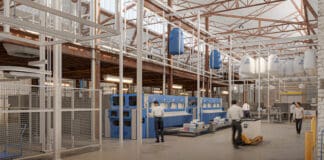By Kathleen Reeves, MD
The healthcare industry continues to face great challenges ranging from ongoing economic disruption to increasing clinician burnout. Both factors are directly related to the impacts of trauma on both patients and care teams. Facility design can play a critical role in helping create safe and trusted environments. In the United States, for example, public schools that have purposefully been restructured to be trauma-informed spaces have seen dramatic and measurable results. That same change is possible in healthcare. Trauma-informed facility design represents an enormous opportunity to improve care, clinician well-being, and even the bottom line.
Trauma and burnout have grown significantly over the last few years for healthcare professionals and patients, with both groups experiencing aspects of trauma and burnout at levels that haven’t been seen in decades.
It is well known that healthcare professionals have a highly demanding job. A recent Vivian Health study asked over 1,000 workers in various industries across the U.S. to rate how stressful their jobs were on a scale of 1 to 10. Nearly half of participants stated that their job was stressful, but healthcare workers took the number one spot. In addition, according to a survey published in the Mayo Clinic Proceedings, 63% of physicians experience moderate to severe burnout symptoms regularly. This increases to 70-90% when less severe symptoms are included. Trauma and burnout have grown significantly over the last few years for healthcare professionals and patients, with both groups experiencing aspects of trauma and burnout at levels that haven’t been seen in decades.
What Is Trauma?
A traumatic event is generally defined as an experience that causes physical, emotional, or psychological distress, or harm. Since 2020, the majority of people have been existing within an epidemic of trauma spanning across a pandemic, economic instability and staggering inflation, civil unrest that rivals 1968, environmental disasters driven by unfettered climate change, great political violence, and worldwide conflicts. This real-time trauma is colliding with one of the most under-recognized issues within the United States: chronic childhood adversity. Nearly one in six people in the U.S. have faced four or more adverse childhood experiences and 64% of Americans have experienced childhood trauma. These numbers are significantly higher in some of the most distressed and marginalized communities, where many health systems and hospitals reside.
Nearly one in six people in the U.S. have faced four or more adverse childhood experiences and 64% of Americans have experienced childhood trauma.
Research has shown that ongoing trauma and generational trauma both cause changes in physiology, including elevation in blood inflammatory markers, alterations in hormone levels, and changes in PET scans. These circumstances often create health challenges and mental health concerns as well as a key disconnect between the patient and caregiver, which can reduce timely care, lower positive outcomes, increase distrust and no-show appointments, and lead to miscommunication and even violence. A recent publication in JAMA noted that 60-80% of patients have not disclosed important information to the healthcare professional treating them because they did not feel that person created a judgment-free zone.
How can the healthcare industry address these concerns to develop more meaningful connections, create better patient outcomes, and improve the experience of both patients and healthcare teams? Research shows that certain facility designs enhanced with specific healthcare worker education, training, and support can create safe, welcoming spaces that help reduce violent outbursts and lower feelings of burnout – improving safety for all. The nonprofit Arnold P. Gold Foundation is even beginning to work with health systems to design such areas, referred to as Gold Human-Centered Spaces.
Humanistic Spaces Put The “Care” Back In Healthcare
Individuals who have experienced significant trauma in their lives are far more likely to suffer from disease – and subsequently need care. Childhood trauma can lead to being two times more likely to develop cancer, three times the occurrence of lung disease and smoking, and 11 times the level of drug use, as well as many other negative health outcomes.
At the heart of trauma-informed work is the understanding that the children who have experienced trauma are not “bad kids,” and they are not even kids doing bad things. These are simply children who have had bad things happen to them. Those bad things and unfortunate circumstances have changed how their bodies react and how they face situations that feel unsafe. The same is true for adults facing similar challenges.

Sadly, for the majority of patients and healthcare staff, healthcare isn’t a space that feels safe, trustworthy, or kind. Patients and staff deserve better.
In collaboration with the caregivers who work in the space and the patients who depend on the space for care, healthcare leaders must ensure that health facilities are physically set up to welcome patients and create a sense of safety and trust, as well as actively seek to prevent re-traumatization. To develop more spaces within healthcare facilities that bring feelings of calmness, safety, and support to patients and healthcare workers, there is a need to shift toward new facility designs that have been successfully tested, such as the designs leveraged by trauma-informed schools in the U.S. When facility spaces are modified to include clear signage, greater accessibility, reduced noise, and features with relaxing aesthetics, health measures have improved and reactionary responses have decreased, studies have shown.
Evidence also backs up that acknowledging the human experience of healthcare workers by encouraging time and resources for peer support, trauma coaches, and safe spaces yields improved well-being, outcomes, and retention. Trauma-informed safe spaces and designs provide opportunities for open collaboration and honest communication between patients and caregivers, which supports better understanding. Healthcare facilities can measure success through patient show rates, staff retention, health outcomes, and costs.
Physical Environments Contribute To A Culture of Safety And Care
Spaces that are safe build trust and help people feel cared for. Safe spaces provide people with non-reactive environments to learn and regulate their emotions. Research shows that safe, welcoming, resilient spaces, as well as trusting and strong relationships, can heal traumas, reverse physiological changes, and reduce violent situations.
Trauma-informed school models offer an excellent example of this transformation. Trauma-informed schools are designed by acknowledging the ways trauma affects students and creating an environment that is encouraging, calming, and supportive.
Trauma-informed facilities keep the human at the heart of their care. By creating spaces of increased safety, trust, and compassion for the patient and the caregiver, the experience and outcomes can improve for all humans.
Facility designers must factor in the circumstances, potential triggers, and general histories of the students (or, in healthcare, patients) when considering layout styles. They must recognize that environments have an impact on attitude, mood, and behavior. Then, using this knowledge, proactively respond with design solutions. For example, potential triggers can be different depending on a person’s experiences: tennis balls can reduce alarming noises when placed at the end of chair legs; calming attitudes can be encouraged with positive messages, access to nature, and soft and comfortable objects; and wayfinding options can be provided to lower anxiety and uncertainties.
Increasing Healthcare Accessibility Through Commercial Conversions
Several key areas to consider before diving into an adaptive reuse project to transform former retail and commercial spaces into outpatient healthcare facilities. Read more…
Studies show that trauma-informed spaces work — and in dramatic ways. A Texas elementary school transformed into a trauma-informed school in 2017 and saw clear results: suspensions decreased from 445 a year to 19, the school passed its state exams for the first time in its history, and teacher retention dramatically improved. The same happened in a school in Hawaii. The number of behavioral incidences went from 2,260 to 1 and out-of-school suspensions went from 2,277 to zero. The graduation rate increased by 10%, and the number of teacher vacancies was cut in half. There are many more examples of similar successes.
Facilities Must Adopt Human-Centered Spaces
Trauma-informed spaces can improve the human experience during a crucial time, whether in schools, healthcare facilities, or additional areas of life. Healthcare leaders can apply this innovative approach to benefit care and safety.
If the healthcare industry hopes to offer compassionate and collaborative care that drives better outcomes, leaders must address the concerns of healthcare professionals suffering from burnout and of patients who do not trust their healthcare professionals. Trauma-informed facilities keep the human at the heart of their care. By creating spaces of increased safety, trust, and compassion for the patient and the caregiver, the experience and outcomes can improve for all humans.
 Kathleen Reeves, MD, is President and CEO of the nonprofit organization The Arnold P. Gold Foundation, a pediatrician, and an advocate for human-centered care. Dr. Reeves previously worked with North Philadelphia schools to improve physical environments to be more welcoming, hire trauma-informed coaches to work with teachers, and establish cultures of safety and compassion. In this new role at the Gold Foundation, she looks forward to partnering with leading hospitals and schools to develop trauma-informed spaces — Gold Human-Centered Spaces. She was also the Founding Director of the Center for Urban Bioethics and Chair of the Department of Urban Health and Population Science at the Lewis Katz School of Medicine at Temple University.
Kathleen Reeves, MD, is President and CEO of the nonprofit organization The Arnold P. Gold Foundation, a pediatrician, and an advocate for human-centered care. Dr. Reeves previously worked with North Philadelphia schools to improve physical environments to be more welcoming, hire trauma-informed coaches to work with teachers, and establish cultures of safety and compassion. In this new role at the Gold Foundation, she looks forward to partnering with leading hospitals and schools to develop trauma-informed spaces — Gold Human-Centered Spaces. She was also the Founding Director of the Center for Urban Bioethics and Chair of the Department of Urban Health and Population Science at the Lewis Katz School of Medicine at Temple University.














 Increasing Healthcare Accessibility Through Commercial Conversions
Increasing Healthcare Accessibility Through Commercial Conversions

![[VIDEO] Job Order Contracting: Accelerating the Projects that Matter](https://facilityexecutivemagazine.kinsta.cloud/wp-content/uploads/2024/05/maxresdefault-324x160.jpg)
